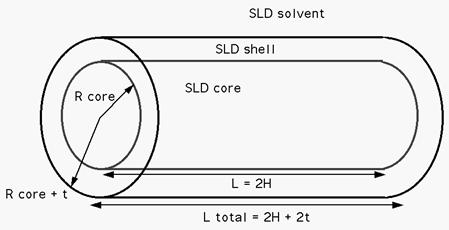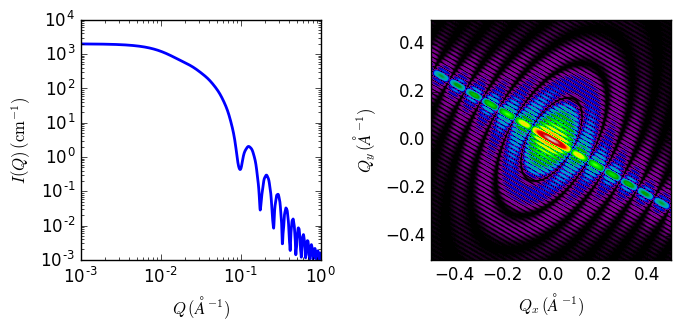core_shell_cylinder
Right circular cylinder with a core-shell scattering length density profile.
| Parameter | Description | Units | Default value |
|---|---|---|---|
| scale | Source intensity | None | 1 |
| background | Source background | cm-1 | 0.001 |
| sld_core | Cylinder core scattering length density | 10-6Å-2 | 4 |
| sld_shell | Cylinder shell scattering length density | 10-6Å-2 | 4 |
| sld_solvent | Solvent scattering length density | 10-6Å-2 | 1 |
| radius | Cylinder core radius | Å | 20 |
| thickness | Cylinder shell thickness | Å | 20 |
| length | Cylinder length | Å | 400 |
| theta | In plane angle | degree | 60 |
| phi | Out of plane angle | degree | 60 |
The returned value is scaled to units of cm-1 sr-1, absolute scale.
Definition
The output of the 2D scattering intensity function for oriented core-shell cylinders is given by (Kline, 2006 [2]). The form factor is normalized by the particle volume.
where
and
and \(\alpha\) is the angle between the axis of the cylinder and \(\vec q\), \(V_s\) is the volume of the outer shell (i.e. the total volume, including the shell), \(V_c\) is the volume of the core, \(L\) is the length of the core, \(R\) is the radius of the core, \(T\) is the thickness of the shell, \(\rho_c\) is the scattering length density of the core, \(\rho_s\) is the scattering length density of the shell, \(\rho_\text{solv}\) is the scattering length density of the solvent, and background is the background level. The outer radius of the shell is given by \(R+T\) and the total length of the outer shell is given by \(L+2T\). \(J1\) is the first order Bessel function.

Fig. 15 Core shell cylinder schematic.
To provide easy access to the orientation of the core-shell cylinder, we define the axis of the cylinder using two angles \(\theta\) and \(\phi\). (see cylinder model)
NB: The 2nd virial coefficient of the cylinder is calculated based on the radius and 2 length values, and used as the effective radius for \(S(q)\) when \(P(q) \cdot S(q)\) is applied.
The \(\theta\) and \(\phi\) parameters are not used for the 1D output.

Fig. 16 1D and 2D plots corresponding to the default parameters of the model.
Reference
| [1] | see, for example, Ian Livsey J. Chem. Soc., Faraday Trans. 2, 1987,83, 1445-1452 |
| [2] | S R Kline, J Appl. Cryst., 39 (2006) 895 |
Authorship and Verification
- Author: NIST IGOR/DANSE Date: pre 2010
- Last Modified by: Paul Kienzle Date: Aug 8, 2016
- Last Reviewed by: Richard Heenan Date: March 18, 2016